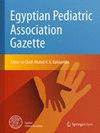Precipitating factors and outcome of acute asthma attack patients attended to the emergency unit at Cairo University Specialized Pediatric Hospital in 2019 “before COVID era”
IF 0.5
Q4 PEDIATRICS
引用次数: 0
Abstract
Abstract Background Asthma is a common and potentially serious chronic disease that imposes a substantial burden on patients, their families, and the community. Objectives The aim of this study was to find a correlation between precipitating factors of acute asthma attacks of patients attending to emergency departments and different factors such as socioeconomic status. Methods The study included patients 2–12 years old of both sexes who were already diagnosed with bronchial asthma coming to ER with acute asthmatic attacks. Data were collected by a questionnaire which includes personal data (name, age, and sex), anthropometric data, score for assessment of socioeconomic status (SES), symptoms of asthmatic attack, risk factors, mode and type of treatment, compliance to treatment, or evaluation of asthma severity and outcome of patients attending to ER. Results This study included 170 patients. Males represented 63.5% of the patients. The mean age of the patients was 5.4 ± 2.7 years. Our patients were distributed into the following: 65.9% were low SES, 22.9% were very low SES, and 11.2% were moderate SES. As regards presenting symptoms of the study group, all the patients (100%) presented to ER with cough, while 88.2% of them presented with wheezes, 85.8% presented with dyspnea, 21.2% of them presented with tightness, and only 0.01% presented with cyanosis. As regards precipitating factors of asthma, the most common precipitating factors among our patients causing attending to ER were irritant inhalers (72.4%), passive smoking (60.6%), exercise (70.5%), certain foods (45.3%), upper respiratory tract infection (12.9%), and non-compliance to asthma treatment (85.2%). The most common causes of non-compliance to treatment were family negligence and illiteracy (34.1%) and poor socioeconomic conditions (17.1%). The majority of patients (96.5%) who could be stabilized with medications were discharged, whereas a merged proportion of critically ill patients (3.5%) required ICU admission. However, no deaths were reported. Conclusion The most common precipitating factors of our patients that led to more attending to ER in the previous 6 months were exercise, irritant inhalers, and non-compliance to asthma treatment.2019年“COVID时代之前”开罗大学儿科专科医院急诊科急性哮喘发作患者的诱发因素和预后
哮喘是一种常见的潜在严重慢性疾病,给患者、家庭和社区带来了沉重的负担。目的探讨急诊患者急性哮喘发作的诱发因素与社会经济状况等因素的关系。方法研究对象为2 ~ 12岁的支气管哮喘患者,男女均可。数据通过问卷收集,包括个人资料(姓名、年龄和性别)、人体测量数据、社会经济地位评估评分(SES)、哮喘发作症状、危险因素、治疗模式和类型、治疗依从性或就诊患者哮喘严重程度和结局的评估。结果本研究纳入170例患者。男性占63.5%。患者平均年龄5.4±2.7岁。我们的患者分布如下:65.9%为低SES, 22.9%为极低SES, 11.2%为中等SES。研究组患者的表现症状均为咳嗽(100%),88.2%的患者表现为喘息,85.8%的患者表现为呼吸困难,21.2%的患者表现为气紧,仅有0.01%的患者表现为发绀。哮喘的诱发因素中,最常见的诱发因素是刺激性吸入器(72.4%)、被动吸烟(60.6%)、运动(70.5%)、某些食物(45.3%)、上呼吸道感染(12.9%)和不遵医服药(85.2%)。不遵守治疗的最常见原因是家庭疏忽和文盲(34.1%)以及社会经济条件差(17.1%)。大多数患者(96.5%)可以通过药物稳定出院,而合并比例的危重患者(3.5%)需要进入ICU。不过,没有死亡报告。结论运动、刺激性吸入器、哮喘治疗不依从性是导致患者在前6个月内就诊较多的最常见诱发因素。
本文章由计算机程序翻译,如有差异,请以英文原文为准。
求助全文
约1分钟内获得全文
求助全文
来源期刊

Egyptian Pediatric Association Gazette
PEDIATRICS-
自引率
0.00%
发文量
32
审稿时长
9 weeks
期刊介绍:
The Gazette is the official journal of the Egyptian Pediatric Association. The main purpose of the Gazette is to provide a place for the publication of high-quality papers documenting recent advances and new developments in both pediatrics and pediatric surgery in clinical and experimental settings. An equally important purpose of the Gazette is to publish local and regional issues related to children and child care. The Gazette welcomes original papers, review articles, case reports and short communications as well as short technical reports. Papers submitted to the Gazette are peer-reviewed by a large review board. The Gazette also offers CME quizzes, credits for which can be claimed from either the EPA website or the EPA headquarters. Fields of interest: all aspects of pediatrics, pediatric surgery, child health and child care. The Gazette complies with the Uniform Requirements for Manuscripts submitted to biomedical journals as recommended by the International Committee of Medical Journal Editors (ICMJE).
 求助内容:
求助内容: 应助结果提醒方式:
应助结果提醒方式:


